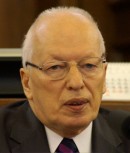

Plenary Lecture
New Models for Wave Energy and Intensive Steel Quenching Processes as Direct and Time Reverse Problems for Non-Homogeneous Hyperbolic Equation

Professor Andris Buikis
University of Latvia
Institute of Mathematics and Computer Science
E-mail: buikis@latnet.lv
Abstract: Intensive quenching processes are one of important branches of modern metallurgical technologies. In new, ecologically clean steel quenching processes important aspect is the heat exchange with the surrounding cold water. In 2005 we proposed the hyperbolic heat equation as mathematical model for intensive steel quenching process.
The idea of the usage of hyperbolic heat equation can be easily transferred to completely different sector of application - to the generation of electricity in sea or ocean by usage of wave energy. It is important to note, that other authors examine the development of the system in time, describing the equipment with ordinary differential equation. Here we describe the equipment in development of both - in time as well as in spatial arrangement of equipment using the three-dimensional hyperbolic heat equation.
In several papers during 2005-2008 we have developed some approaches (Green function method, original conservative averaging method) for the solving the time reverse problems for the parabolic part of the hyperbolic heat equation.
In this lecture we develop some new ideas for the solution of time reverse problems for the non-homogeneous hyperbolic heat equation. We consider one dimensional, two-dimensional and three-dimensional statement for non-homogeneous equation with non-homogeneous boundary conditions. Such statements allow constructing mathematical models for wave power plants in connection with other equipment, for example, with wind power. Boundary conditions could be different types, thus allowing us to use Green function method. We have been able to generalize the Green's function method to areas, which consist of several canonical connected sub-areas. They lead us to well-posed statements for determination of initial heat fluxes instead of ill-posed statements in our previous papers.
Brief Biography of the Speaker: Andris Buikis received the M.S. in numerical mathematics from University of Latvia (Faculty of Physics and Mathematics) in 1963 and Dr.math. (Candidate of Science in former USSR), University of Latvia, 1970. He was Junior Researcher, Senior Researcher, Computing Centre, University of Latvia, 1962 – 1972. Assistant Professor and Head of Chair of Applied Mathematics, 1972 – 1976 and Head of Chair of Differential Equations and Numerical Methods, Faculty of Physics and Mathematics, University of Latvia, 1976 – 1984. Dr.habil.math. (Doctor of Science in former USSR), University of Kasan, Russia, 1988. Professor, University of Latvia, 1991. Director, Institute of Mathematics, Latvian Academy of Sciences and Latvian University, 1991 - 1996; 2003 – 2006 and Director, Science and Dialogue Centre of Latvia, 1993 -2007. Head of Laboratory of Mathematical Technologies, Institute of Mathematics and Computer Science, University of Latvia 2006-2010.
In 2010 he was elected as Member of Saeima (Latvian Parliament). Full Member, Latvian Academy of Sciences, 1997. Member, Senate of the Latvian Academy of Sciences, 1994 –2012. The Latvian Academy of Sciences Piers Bohl Prize for a cycle of papers “Method of Conservative Averaging, Theory and Applications”, 2005. Member of Editorial Advisory Board, Journal Mathematical Modelling and Analysis (The Baltic Journal on Mathematical Applications, Numerical Analysis and Differential Equations), Lithuania 1999- and Associate Editor of WSEAS Transactions in Heat and Mass Transfer 2007-.